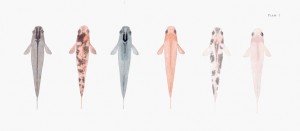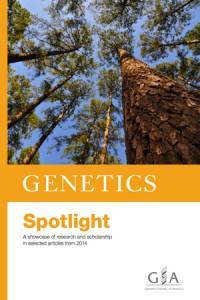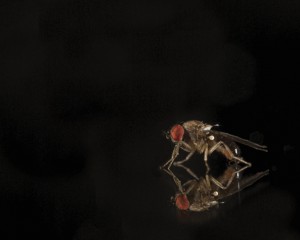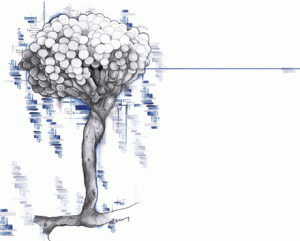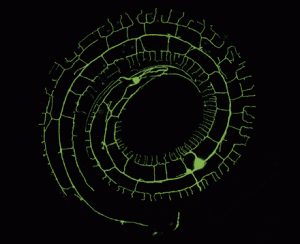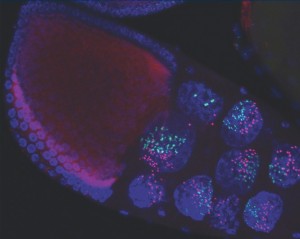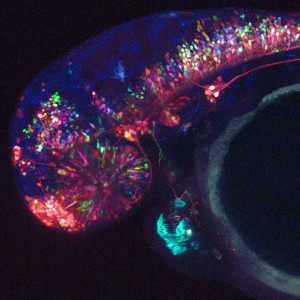Enter your address to receive notifications about new posts to your email.
Science & Publishing
-
Science & Publishing
Medaka Genetic Toolbox: Old fish, new tricks
Since the 17th century, the tiny medaka fish that dart through rice paddies in Japan have been bred as living ornaments. Though in the wild they are a nondescript mud color, medaka occasionally turn up in flashier mutant varieties — orange-red, pearlescent white, black splotched — that were much prized by generations of fish fanciers.…
-
Science & Publishing
Forest forecasts
In 2009, after five years parching under the arid blue skies of Calcena in northeastern Spain, dozens of neat rows of maritime pine seedlings had grown unevenly. Some of the seedlings had died years ago, some were stunted but hanging on, while others grew tall and green. The trees were not in their native soil.…
-
Science & Publishing
Spotlight on 2014 research
From animal domestication to human genome variation, from loblolly genomes to lager genomes, from wild zebrafish sex to untangled metagenomes, last year brought plenty of high points for the GSA journals. So gathering a small selection of those high points into the 2014 Spotlight booklets was a challenging, but rewarding task for the editors of GENETICS…
-
Science & Publishing
Meeting report: Defending Drosophila
Fruit flies suffer from an image problem. Maybe it’s the alliteration in the name, or the association with bananas, but Drosophila have become a go-to target for politicians looking to ridicule wasteful public spending. In February, presidential candidate and US Senator Rand Paul (R-KY) questioned the NIH for spending: “…a million dollars trying to determine…
-
Science & Publishing
April GENETICS Highlights
The April issue of GENETICS is out now! Check out the highlights below of the full Table of Contents here. Nascent transcription affected by RNA polymerase IV in Zea mays, pp. 1107–1125 Karl F. Erhard Jr., Joy-El R. B. Talbot, Natalie C. Deans, Allison E. McClish, and Jay B. Hollick RNA polymerase IV (Pol IV) is required…
-
Science & Publishing
New in G3: Genomic selection, ortholog detection, and Drosophila lines with global diversity
Check out the April issue of G3! Investigations A Bayesian Model for the Analysis of Transgenerational Epigenetic Variation Luis Varona, Sebastián Munilla, Elena Flavia Mouresan, Aldemar González-Rodríguez, Carlos Moreno, and Juan Altarriba G3 April 2015 5:477-485; Early Online January 23, 2015, doi:10.1534/g3.115.016725 Abstract | Full Text | Full Text (PDF) | Supporting Information Identification of…
-
Science & Publishing
Mutant Screen Report: touchy worms
Do you have results from a mutant screen to publish? G3’s Mutant Screen Reports allow you to publish succinct descriptions of useful genetic screens in a convenient format. The Reports fulfill one of G3’s goals: to make data from screens available to the community in a timely fashion. If you gently touch the front half…
-
Science & Publishing
A glaring paradox clarified
Last week, GENETICS published an editorial by Editor-in-Chief Mark Johnston about the influence of the Journal Impact Factor on science and discussed an alternative metric that emphasizes the research experience of the journal’s editors. The following is Mark’s response to some of the feedback he’s received: In my editorial I proposed a new metric for…
-
Science & Publishing
March GENETICS Highlights
The March issue of GENETICS is out now! Check out the highlights below of the full Table of Contents here. Locally epistatic genomic relationship matrices for genomic association and prediction, pp. 857–871 Deniz Akdemir and Jean-Luc Jannink In breeding studies a distinction is made between the genetic value (additive + epistatic genetic effects) and…
-
Science & Publishing
New in G3: Fruit fly CatWalk, well fed Drosophila, and house fly sex determination
Just in time for the 2015 GSA Drosophila Research Conference, the new issue of G3 features FlyCatWalk for sorting live Drosophila based on morphometric traits, a Drosophila genome-wide association study for nutritional indices, and autosomal versus y-linked male determination in house flies. Check out the Table of Contents below! Investigations The FlyCatwalk: A High-Throughput…
-
Science & Publishing
Chasing Brainbows
Whether your computer screen displays a spreadsheet, a movie, or a LOLcat, you’re seeing pinpoints of light in only three colors: red, green, and blue. But by varying the relative intensity of these three components, a pixel can transform into any one of a spectrum of millions of colors. The same principle lies behind the…


